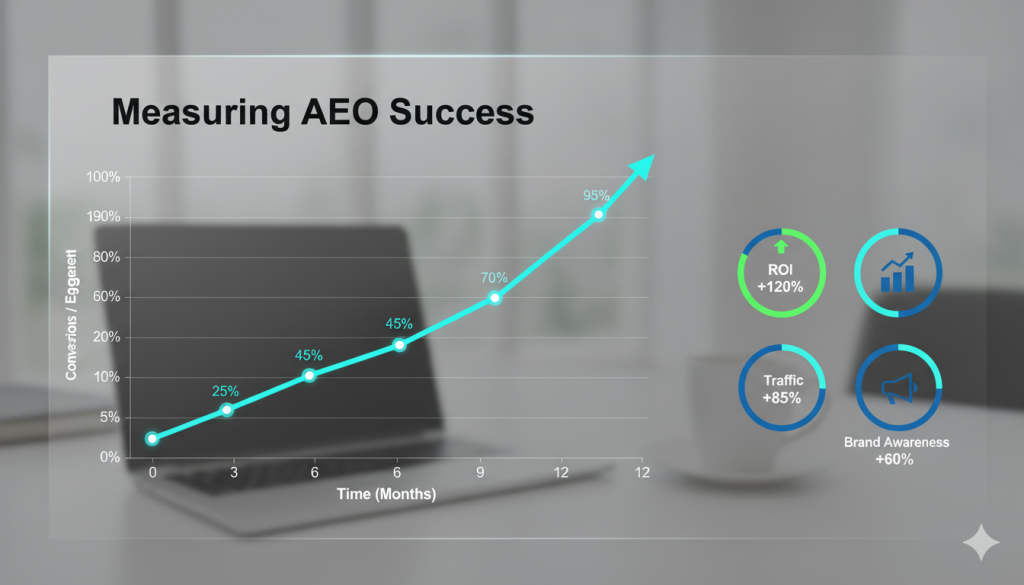
What Metrics Are Used to Measure AEO Success?
Table of Contents
If you’re asking, “What metrics are used to measure AEO success?”, the answer depends on whether you’re talking about digital marketing (Answer Engine Optimization) or international trade (Authorized Economic Operator). Let’s break down both sides so you get a clear picture—and see which metrics matter most for your goals.
Metrics for Answer Engine Optimization (Digital Marketing)
AEO in digital marketing focuses on how your content gets picked up by AI-powered answer engines—think Google featured snippets, ChatGPT responses, or voice assistants. Success here hinges on three main types of metrics:
Visibility Metrics
- Featured snippet presence: How often your content appears in zero-click search results
- Knowledge panel and PAA appearance: Inclusion in Knowledge Panels or “People Also Ask” sections
- Answer box ownership: Percentage of relevant queries where your answer shows first
- Voice search selection: How frequently voice assistants use your content as their spoken answer
Engagement Metrics
- Zero-click impressions: Times your answer is viewed, even if users don’t click through
- Post-click engagement: Time on page, scroll depth, or additional interactions
- Answer sufficiency: Whether your content completely satisfies the user’s need (based on return searches or actions)
- Bounce rate in context: If people leave quickly but after finding what they wanted, that’s a win
Business Impact Metrics
- Conversions from answer-driven traffic: Sign-ups or purchases
- Micro-conversions: Downloads, leads, or other meaningful actions
- Pipeline contribution: Share of leads or sales influenced by AEO-optimized content
- Brand lift: Improvement in brand recall or sentiment linked to high answer engine visibility
You might also wonder: “How do companies track and report on these metrics?” Most use SEO or analytics dashboards, plus competitor benchmarking and weekly performance scorecards. [3]
Metrics for Authorized Economic Operator (International Trade)
If you’re thinking about global trade, AEO here means showing you’re a trusted trading partner. Success is measured by compliance, efficiency, and stakeholder trust.
Key Performance Indicators (KPIs)
- AEO application and approval rates: Indicate adoption and program reputation
- AEO-handled trade volume: Shows program influence in total imports/exports
- Time to clear goods (AEO vs. non-AEO): Faster clearance means better efficiency
- Inspection rate reduction: Fewer physical/document checks for certified members
- Compliance and transparency: Audit success, document accuracy, crisis readiness
- Feedback and reputation: Regular feedback cycles and gaining eligibility for future trade advantages
Here’s a simple side-by-side comparison that sums up both approaches:
| Metric Type | Digital Marketing (AEO) | International Trade (AEO) |
|---|---|---|
| Visibility | Featured snippets, PAA, voice | AEO-certified trade volume |
| Engagement | Post-click stats, answer score | Time to clear goods |
| Business Impact | Conversions, pipeline | Reduced cost/inspection, compliance rates |
| Reputation | Brand sentiment/mentions | Stakeholder trust, audit results |
Key Things to Remember
- Choose the right metrics: Focus on what drives results for your industry and region
- Track both visibility and impact: Measuring only impressions or clearance speed isn’t enough—tie your efforts to outcomes
- Review regularly: Analyze dashboards and feedback to spot new opportunities or issues
Numbers tell the story, whether you’re aiming for the top answer in a Google search or smoother customs clearance at the border. If you’re looking for specifics, recent surveys show that up to 65% of marketers now track featured snippet acquisition and answer box share as primary metrics for digital AEO success[3] (https://www.searchenginejournal.com/google-featured-snippets-study/437829/).
So the next time you’re optimizing content or evaluating trade program results, ask yourself: Which AEO metrics truly matter for your goals—and are you tracking them today?
